
by Timothy Oleson Tuesday, April 7, 2015
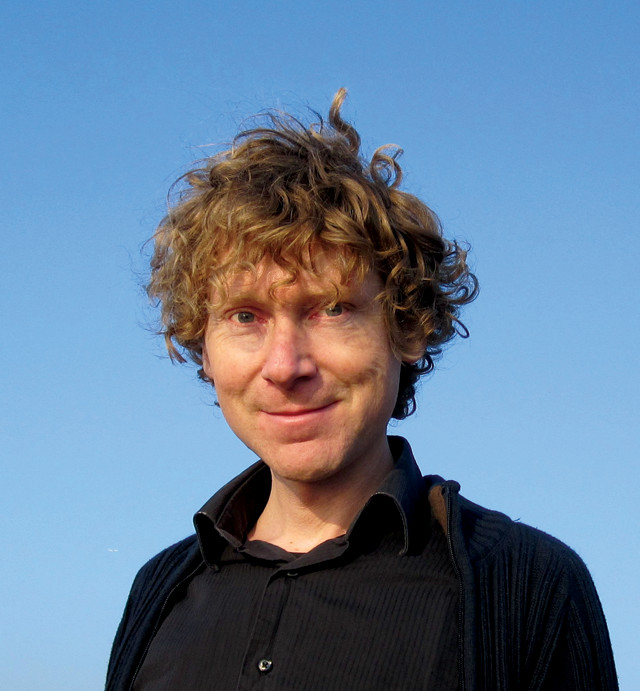
Volcanologist Clive Oppenheimer. Credit: courtesy of Clive Oppenheimer.
North Korea is perhaps the most isolated country in the world, with a people, culture and landscape largely veiled from outside observation, which rarely hosts few Westerners. However, in recent years a smattering of western scientists have visited the country, including volcanologist Clive Oppenheimer from the University of Cambridge in England. In 2011, Oppenheimer was invited by North Korean scientists who were concerned about a sleeping giant of a volcano on the northern border with China that had shown signs of restlessness. A few weeks later, he found himself on the imposing but beautiful mountain, known as Paektu-san to the Koreans (or Changbaishan in China), with a small team trying to unravel the volcano’s past and potential future activity. He has returned to North Korea twice since, and is looking to extend the rare collaboration further.
Oppenheimer has studied volcanoes across the planet, focusing mainly on what volcanic gas emissions tell us about the subsurface, as well as about their effects on the atmosphere, environment and people. Among his efforts, he has spent more than a decade as part of the U.S. Antarctic Program (USAP) examining Mount Erebus, Earth’s southernmost active volcano.
Oppenheimer also penned the well-received popular book, “Eruptions That Shook the World,” and regularly makes TV, radio and public-speaking appearances. In 2015, he is scheduled to begin shooting a 3-D/IMAX documentary based on “Eruptions That Shook the World” with acclaimed director Werner Herzog.
EARTH’s Timothy Oleson spoke with Oppenheimer last fall — as he was gearing up for his 12th field season at Erebus — about working in Antarctica, North Korea and elsewhere, and about why a good cup of coffee is crucial when the sun never sets.
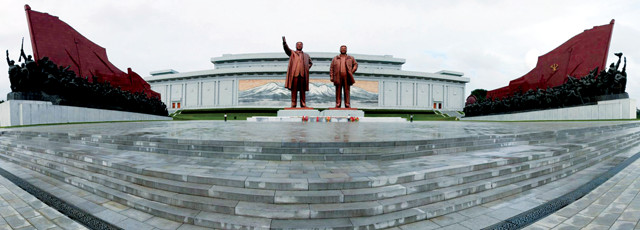
Statues of Kim Il Sung and Kim Jong Il stand at the Mansu Hill Grand Monument, or Mansudae, in North Korea's capital, Pyongyang. In the background, a mural of a mountain scene, including Mount Paektu, adorns the Korean Revolution Museum. Credit: courtesy of Clive Oppenheimer.
TO: How did you and your colleagues get involved in working with North Korean scientists at Paektu-san, or Mount Paektu, in 2011?
CO: There was quite a complex set of intermediaries. The call I got was from Richard Stone of Science Magazine, who was based in Beijing at the time and had made a few trips to North Korea. He was approached, in sort of an indirect way [through North Korean and Chinese nongovernmental organizations]. The North Koreans were anxious about the Paektu volcano because it had been through a phase of unrest. They wanted some outside advice on the volcano’s surveillance. So, on rather short notice, I got this invitation and called up James [Hammond, a seismologist at Imperial College London], with whom I’d worked before in Eritrea. We both went over in 2011, and that was our first fact-finding mission.
TO: What have you done there since that first trip?
CO: [After 2011] we spent time trying to get funding together, which came through the American Association for the Advancement of Science and the Richard Lounsbery Foundation, and that allowed us to go back in summer 2013. James put some seismometers in the ground, and I collected a lot of rocks with my then-graduate student Kayla Iacovino (now at the U.S. Geological Survey). James and I went back again last summer to do a service run on the stations, look at a few new sites on and around Paektu, and collect more rocks.
We’re at the stage where the data are starting to be amassed, but there is a lot of analytical work still to do on the rocks, and there are not a lot of research findings yet. It’s a work in progress. We’re also very aware of the science diplomacy angle of the project. It’s clearly an unusual program. We’re not aware of many precedents or comparable programs in North Korea with collaborations with the West. That geopolitical dimension makes it a very fascinating project.
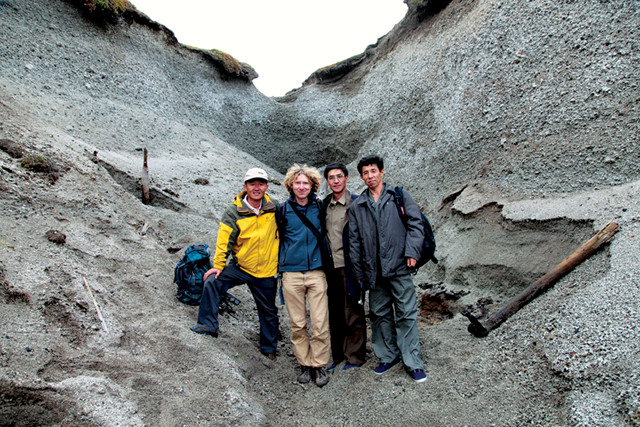
Oppenheimer stands with colleagues from the Korean Earthquake Bureau amid a section of pumice deposited by the Millennium Eruption of Mount Paektu in the 10th century. Credit: courtesy of Clive Oppenheimer.
TO: Other than monitoring for activity, what are some of the big questions about Paektu that interest you?
CO: The first-order question is why Paektu is there in the first place. It is 1,000 kilometers from the Japanese subduction zone, and it’s just not really where a volcano should be. Part of the aim of the seismological work is to test some of the different models for the volcano’s origin. Another big question is to better understand the Millennium Eruption [thought to have occurred in about A.D. 940]: Where were the magmas stored in the crust? What triggered the eruption? Why did it involve two different magma types? There’s a rhyolite and a trachyte that came out later. What were the contemporary impacts of the eruption on people in the region, and what kind of a global or hemispheric climate signature might the eruption have had? Then the third element: What’s the state of the volcano currently — where is melt stored and what can we draw from our understanding of the Millennium Eruption and other eruptions there that we can take forward to think about the hazards in the future? In an ideal world, you’d have one network of seismometers. It’s much more complex when you have an international border cutting through the middle of your volcano.
TO: You mentioned the science diplomacy angle of the project. Do you see yourself as a de facto diplomat?
CO: I don’t see myself as a diplomat; I try to be diplomatic because it’s a sensitive project that needs to be treated carefully. I try to just be a scientist and work in the way that I would normally work with any other collaborative project, but within the confines that prevail when you work in North Korea. One of the things we were quite clear about, though, was that the data collected would be made publicly available — the seismic data will go into the global catalog. And we also want to publish in the usual open journals with our Korean colleagues. They have the most at stake in understanding the volcano, and we collaborate very closely in defining the research goals.
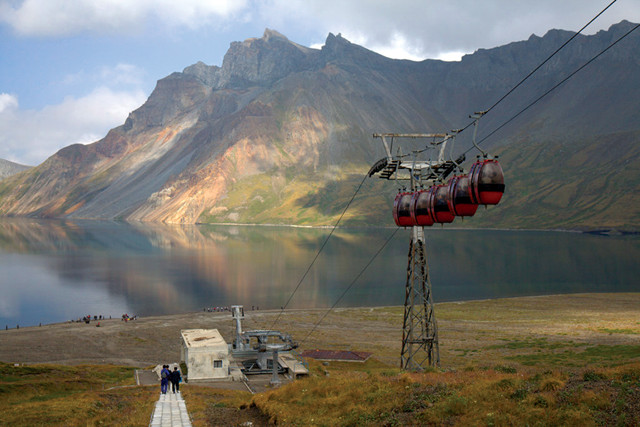
Scientists descend to a research station near Lake Chon, within Mount Paektu's summit crater. Credit: courtesy of Clive Oppenheimer.
TO: Why do you think the North Koreans reached out to western scientists instead of collaborating exclusively with the Chinese scientists studying the volcano?
CO: There have been contacts with the Chinese. And some of the North Korean scientists we worked with have spent time in China. I think the geopolitics are so fluid that maybe it’s a question of wanting to work in different kinds of bilateral arrangements to try to take things forward. Our ambition is, at some point in the future, to host an open international meeting with the North Korean scientists. There’s quite a community of geoscientists interested in Paektu in the U.S. and the U.K., in Japan and South Korea, and in China as well as in North Korea.
TO: Describe the landscape at Paektu. Do you ever get so wrapped up that you forget where you are and just admire the view?
CO: It’s spectacular. There is a crater several miles across with a beautiful lake. The crater rim is very precipitous, and when you get to the top you look down into the crater at the lake and across to the Chinese border, and you can see all the tourists on that side. For me, one of the most striking things is the landscape on the volcano’s upper flanks, which are covered in pumice from the Millennium Eruption. What’s remarkable is that it looks like a tundra landscape. But when you find sections exposing the base of the 10th-century pumice … [you see] these large trees that were killed in the eruption but are in a remarkable state of preservation. They attest to a very mature forest that was there more than a thousand years ago. It really strikes me that, in over a millennium, nothing like that original ecosystem has come back, which underlines the lasting environmental and ecological impacts that eruptions of that scale can have. When you get to the base of [the pumice layer], it’s like going in a time-travel machine and it gets me thinking about what the area was like at that time. Did people wander up on these slopes and use the forests? What did the volcano look like — was it quite a bit higher than it is today? I do get a bit lost in that sort of time travel, thinking about what was going on in China and the Korean Peninsula and elsewhere in the world at that time.
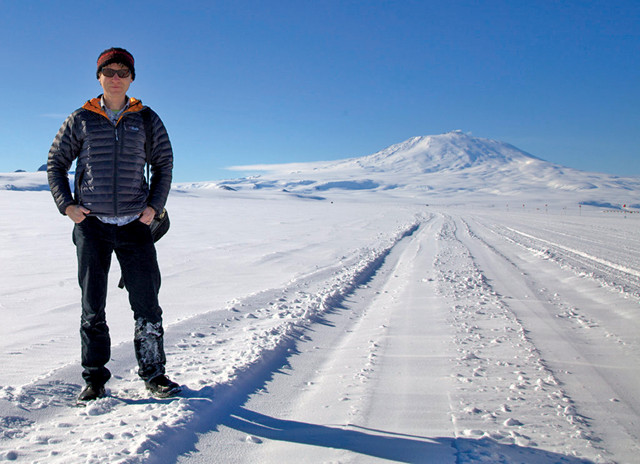
Oppenheimer has now spent 12 field seasons studying Erebus as part of the U.S. Antarctic Program. Credit: courtesy of Clive Oppenheimer.
TO: Have you been able to see other parts of the country or culture in your time there?
CO: The first time we went, in 2011, we arrived in the late afternoon and the next morning we were in the audience at a big military parade with Kim Jong Il and Kim Jong Un watching over us. The military hardware came out and they had these incredible displays where tens — if not hundreds — of thousands of people had colored placards that they’d hold up and down to spell phrases in Korean and make pictures. It was pretty amazing to be at an event like that within 24 hours [of arriving]. And we were taken to a number of other sites that are important to the North Koreans — the mausoleum of Kim Il Sung among them. Paektu itself is revered by the Korean people as their birthplace, and by the North Koreans because Kim Il Sung led the struggle against the [Japanese] occupation from camps on its slopes.
So we’ve seen a little bit around Pyongyang and a bit around the mountain. And if this program continues in the next few years, we would like to broaden out. There are other volcanoes nearby, and it would be very valuable in understanding the origins of volcanism in the region to look at their nature — the geochemistry, the petrology and whether there are any signs of unrest.
TO: Do any previous experiences working on other volcanoes compare to your experience in North Korea?
CO: What makes this stand out is the isolation of the country and its scientists. Eritrea is another country that has been under international sanctions and has had various issues to deal with in recent years, but the scientists [James and I] worked with there had trained in Europe, and are on the Internet. Things are that much more complex in North Korea because the scientists there don’t get to go to international meetings, they have limited access to journals, so it’s really difficult for them to be at the cutting edge of the discipline. They’re very well trained in geophysics and the mathematical foundations of the subject. But what’s been going on in volcanology today … [in terms of] looking at hazards and risks, they’re not really familiar with.
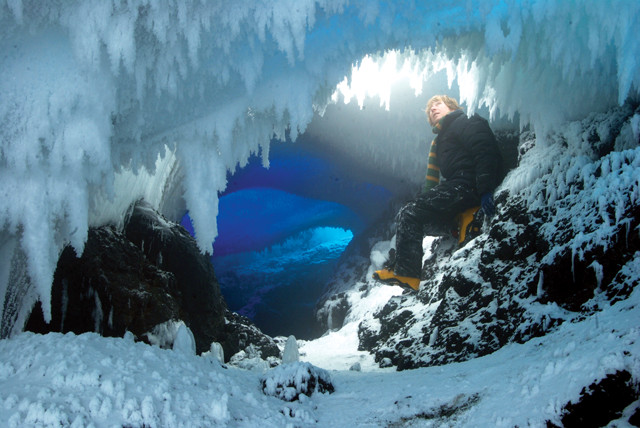
Oppenheimer peers out from inside an ice cave near Mount Erebus. Credit: courtesy of Clive Oppenheimer.
TO: Can you even keep track of how many volcanoes you’ve been to at this point? Are there others you haven’t been to that you’d like to get to in the future?
CO: It’s easier for me to keep track of the ones that I want to go to still. I’d love to go to the Tibesti [Mountains] in Chad — that’s been kind of a dream. Of course there are so many. I wouldn’t mind going to Io [the Jovian moon known for its volcanic activity], but I don’t think that’s in the cards. I’ve been very lucky; my luckiest day in some ways was to fall into the U.S. Antarctic Program — fall into it and stay there. I’ve been working on Erebus … and that’s been sensational. It’s the best natural laboratory in which to study volcanic processes that I’ve ever seen.
TO: What are the particular challenges of working at Erebus?
CO: Keeping your fingers warm — particularly when you have to take your gloves off and fiddle around with equipment up at the crater rim. Keeping equipment powered is a big challenge. It’s a problem on any volcano if you don’t have a convenient [power] socket, but an added problem at Erebus is that solar is only good for part of the year. And winter storms are so violent that [instruments left year-round] are routinely destroyed. We’ve made wonderful observations there in the summertime [during the December field season], but it’s more difficult to know what the volcano is doing the other 11 months of the year. One of the big challenges for the future is to innovate in the power and telemetry fields so we can do more of the things that we do in the summer through the whole year. You also have to be patient and sit out bad weather … and just seize the opportunity of good weather. Then, you can work 24 hours a day because the sun never sets at that time of year.
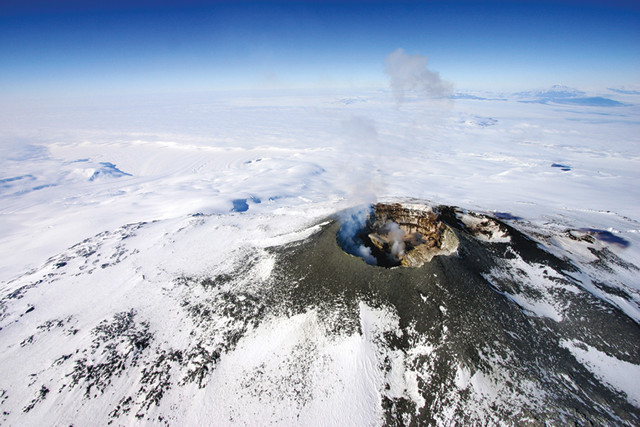
Puffs of volcanic emissions rise from the summit of Antarctica's Mount Erebus. Credit: courtesy of Clive Oppenheimer.
TO: So, sunlight all day long and maybe a little coffee is what it takes to keep you going while you’re there?
CO: That’s right. Even if you’re not working, it’s difficult to get a good night’s sleep at altitude with 24-hour daylight, and often the wind rustling the tent and making the wind generators howl. People do get pretty sleep deprived.
When you’re working with the USAP, you don’t really want for anything; it’s very well supported. But the one thing is, Folger’s is not coffee, and Hershey’s is not chocolate. [laughs] I take coffee and chocolate supplies down there. We have a nice espresso set, and some pretty serious coffee drinkers.
© 2008-2021. All rights reserved. Any copying, redistribution or retransmission of any of the contents of this service without the expressed written permission of the American Geosciences Institute is expressly prohibited. Click here for all copyright requests.